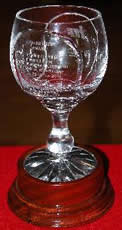Congratulations to Andrew Ashcroft and Professor Bill Stronge on gaining the Howard Brody award for best paper at the International Tennis Federation's Tennis Science & Technology II Conference in London (July 28-30, 2003).
If we can model the behaviour accurately, it will allow the manufacturers to produce a ball with the characteristics they require.
Andrew Ashcroft

The paper was titled "Dissipation during bounce of tennis balls". Andrew, a Gates scholar, currently in the final year of his research for a PhD explains the nature of the project:
"The International Tennis Federation is concerned that the game has become too fast. There are many different types of tennis ball available, but no-one really knows, in detail, how a tennis ball behaves in practice. We are looking at how the energy is dissipated during the bounce of the balls. We have established that 40% of the energy lost during the bounce can be accounted for by air drag and hysteresis, we are now looking at sound dissipation, heat loss and resonance as other potential mechanisms. There is a lot of expertise in the Department on friction and fluid mechanics which has been very useful for this work.
"Our paper at the conference produced a lot of interest from the manufacturers, as many aspects of the way tennis balls behave are counterintuitive. For instance, if you make the ball larger, it actually goes faster. It is difficult to model the behaviour of a ball precisely, as although a tennis ball is a thick walled sphere, it is actually in a high state of compression when it leaves the ground as these high speed photos show. If we can model the behaviour accurately, it will allow the manufacturers to produce a ball with the characteristics they require."

Somewhat suprisingly, Andrew is not a tennis player at all. He does Captain the University's ice hockey team, however, and hence the interest in Sports Engineering.

